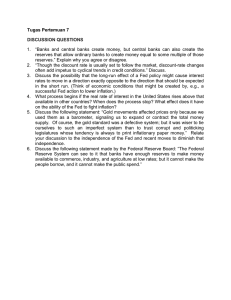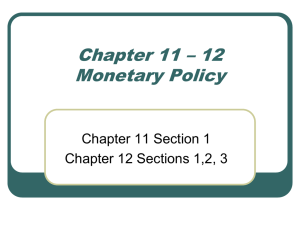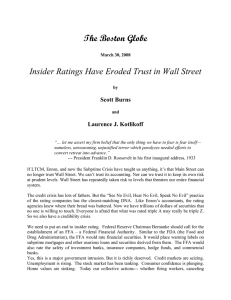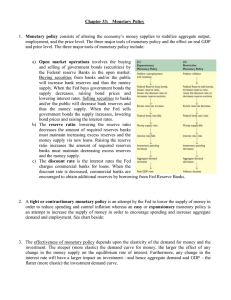THE FEDERAL RESERVE SYSTEM GOALS OF MONETARY POLICY 1
advertisement
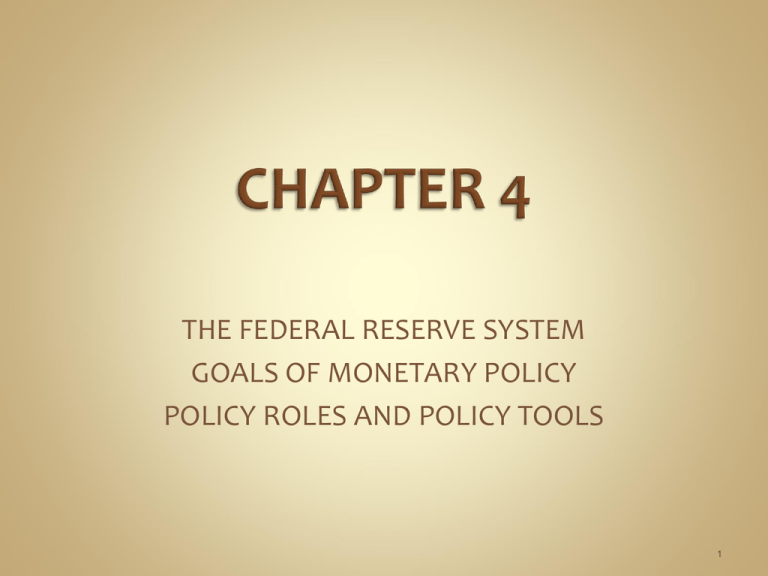
THE FEDERAL RESERVE SYSTEM GOALS OF MONETARY POLICY POLICY ROLES AND POLICY TOOLS 1 Federal Reserve Act passed in 1913 Largely in response to Panic of 1907 John Pierpont Morgan was major supporter Income earned from interest received from investments in government securities Member banks must buy “stock” in the district/regional bank. Stock pays a maximum dividend of 6% Facilitate operations within the banking system by clearing checks, replacing old currency, and providing loans (through the discount window) to depository institutions in need of funds. 2 Structure of the Federal Reserve Commercial banks can elect to become member banks if they meet specific requirements of the Board of Governors Board of Governors (7 members). Appointed for 14 year terms (2 yr. rotations). Chairman (appointed by U.S. President - 4 years) 12 District banks; NY is chief-among-equals. 25 branches. Boston (A), NYC (B), Philadelphia (C), Cleveland (D), Richmond (E), Atlanta (F), Chicago (G), St Louis (H), Minneapolis (I), KC (J), Dallas (K), San Francisco (L) (See Exhibit 4.1, page 75) 3 3.Member banks; All commercial banks chartered by OCC (national banks) are members. Many state charted banks are also members. 4.Federal Open Market Committee (FOMC) The policy making body Voting members: Board of Governors and 5 presidents from the 12 banks (12). President of NY Fed is always a member. 4 Stable prices Inflation measures: Consumer Price Index (CPI) Inflation drives values of financial assets down, real assets up. Full employment Supply of credit and capital (currency) Funding economic growth Assure financial market stability Liquidity supplier of last resort (Bear Stearns, others) 5 D.Supervisory powers over member banks Auditing and Compliance Chartering and Capital Requirements Reserve Requirements (1980: DIDMCA) Type of liability Net transaction accounts (7-days) Percent of Liabilities Effective date $0 to $12.4 million 0 1/1/2009 More than $12.4 million to $79.5 million 3 1/1/2009 More than $79.5 million 10 1/1/2009 Nonpersonal time deposits 0 12/27/1990 Eurocurrency liabilities 0 12/27/1990 6 Role of the Fed’s Trading Desk 7 If a change in monetary policy is appropriate, the FOMC decision is forwarded to the Trading Desk (Open Market Desk) at the NY Fed through a policy directive. a. Fed purchase of securities – To lower the federal funds rate, traders purchase Treasury securities from securities dealers. The dealers’ bank account balances increase causing an increase in the supply of funds. b. Fed sale of securities – To increase the federal funds rate, traders sell government securities to government securities dealers. As the dealers pay for the securities, their bank balances decrease leading to a decrease in the supply of funds. c. Fed trading of repurchase agreements - Purchases Treasury securities from government securities dealers with an agreement to sell back the securities at a specified date in the near future Reserve requirements for deposit liabilities Open market operations Buying government securities by the Fed Selling government securities by the Fed Discount rate: cost of borrowing from the Fed Margin Requirements for Security Markets Impact on Firms of Monetary and Fiscal Policy M.P. affects the cost of [new] capital. Affects expansion plans. Fiscal Policy; create Government demand for capital goods. 8 Role of the Fed’s Trading Desk (Cont.) d. Control of M1 versus M2 The optimal form of money should (1) be controllable by the Fed and (2) have a predictable impact on economic variables when adjusted by the Fed. M1 includes currency held by the public and checking deposits (such as demand deposits, NOW accounts, and automatic transfer balances) at depository institutions. M2 includes everything in M1 as well as savings accounts and small time deposits, MMDAs, and some other items. M3 includes everything in M2 in addition to large time deposits and other items. 9 • The Reserve Requirement is the proportion of bank deposits that must be held in reserve. This has historically been set between 8 and 12 percent of transaction accounts. • By reducing the reserve requirement, the Board increases the proportion of a bank’s deposits that can be lent out. The lower the reserve requirement, the greater the lending capacity of a depository institution. • Cash deposits create new excess reserves – create new loans. • Excess reserves loaned out and new deposits created. • The process continues until the last deposit (less Required Reserves.) too small to lend. • What happens when Cash is withdrawn? Reserves depleted, leading to... • Multiple contraction in sources of reserves • Banks resort to borrowing in the federal funds market or • Borrowing from the Federal Reserve (discount window) 10 1. During the crisis, the Fed provided funding through the discount window: a. Bear Stearns, a non-depository institution, was able to borrow at the discount window through a loan to J.P. Morgan Chase. 2. Facilities created by the Fed: a. In 2008, the Fed created various facilities that provided loans to financial institutions that purchased particular types of debt securities. In 2010, the Fed closed most of these facilities. b. Term Asset-Backed Security Loan Facility (TALF) - created to provide financing to financial institutions purchasing highquality bonds backed by consumer loans, credit card loans, or automobile loans. 11 ■ Each country has its own central bank that controls the money supply and monetary policy a. Central banks of other industrialized countries use open market operations and reserve requirement adjustments as monetary policy tools. b. The Fed must consider economic conditions in other countries when assessing the U.S. economy. 12 ■ A Single Eurozone Monetary Policy a. The European Central Bank (ECB), based in Frankfurt, is responsible for setting monetary policy for all European countries that use the euro. The ECB’s monetary goals are price and currency stability. b. Impact of the Euro on Monetary Policy i. Any changes in the money supply affect all European countries that use the euro. ii. Prevents participating countries from solving local economic problems using their own unique economic policies. 13 As nation's central bank, responsible for coordinating policy with other CBs Foreign Bank Supervision Enhancement Act (1991); Fed oversight of foreign banks operating in US Approve entry of foreign banks to operate in US Basel Accords (See Chapter 18) Capital Adequacy and Risk Management 14 Is the Fed a private bank? What are the principal objectives of the Federal Reserve System? How is the Federal Reserve organized? What is the function of the board of Governors? What is the function of the Federal Open Market Committee (FOMC)? What are the goals of Monetary Policy? Fiscal Policy? How do changes in Monetary Policy affect business? Does supply always affect demand? How does they Fed increase (decrease) the monetary base? 15


